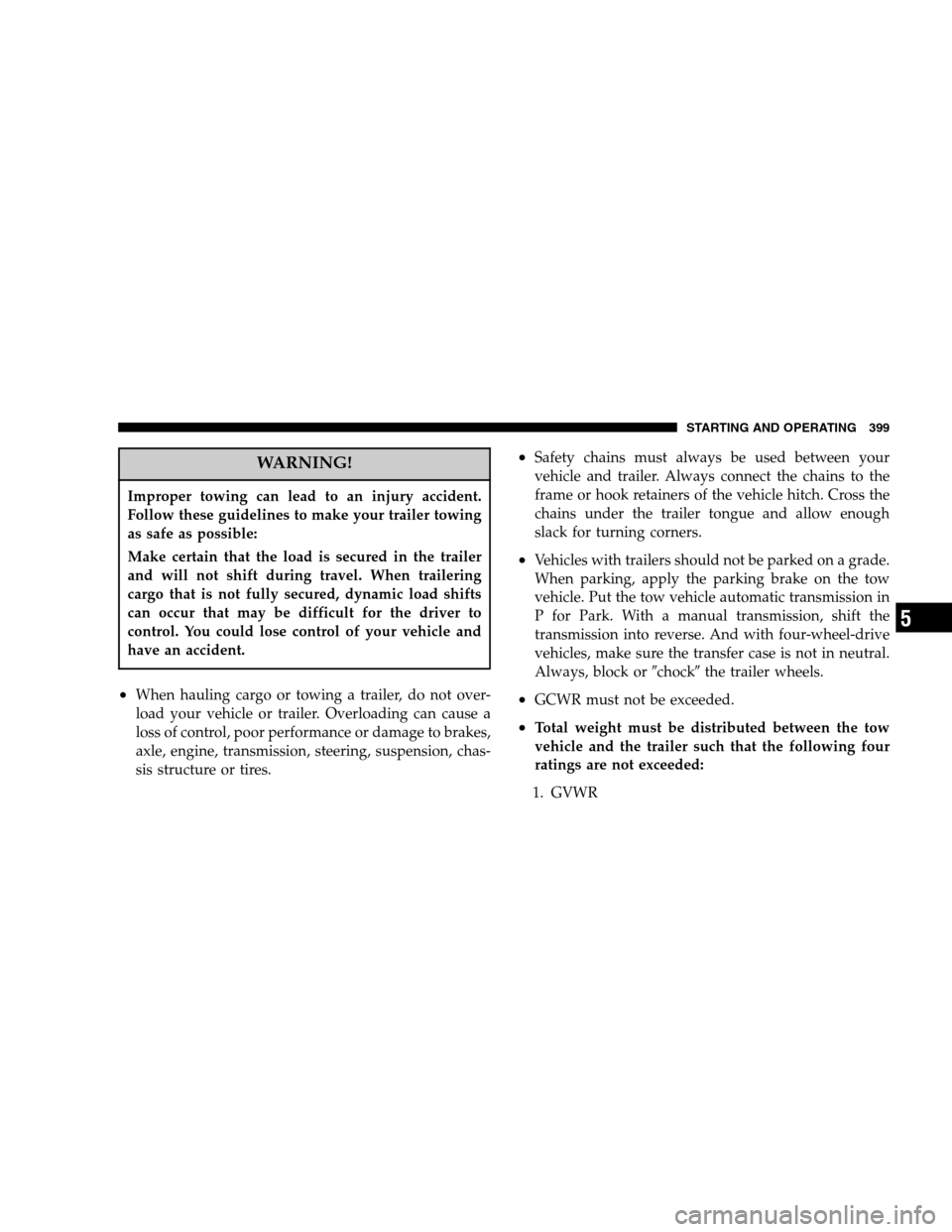Page 369 of 568
loading may be required for high-speed vehicle opera-
tion. Refer to original equipment or an authorized tire
dealer for recommended safe operating speeds, loading
and cold tire inflation pressures.
WARNING!
High speed driving with your vehicle under maxi-
mum load is dangerous. The added strain on your
tires could cause them to fail. You could have a
serious accident. Don’t drive a vehicle loaded to the
maximum capacity at continuous speeds above 75
mph (120 km/h).
Radial-Ply Tires
WARNING!
Combining radial ply tires with other types of tires
on your vehicle will cause your vehicle to handle
poorly. The instability could cause an accident. Al-
ways use radial ply tires in sets of four (or 6, in case
of trucks with dual rear wheels). Never combine
them with other types of tires.
Cuts and punctures in radial tires are repairable only in
the tread area because of sidewall flexing. Consult your
authorized tire dealer for radial tire repairs.
STARTING AND OPERATING 369
5
Page 399 of 568

WARNING!
Improper towing can lead to an injury accident.
Follow these guidelines to make your trailer towing
as safe as possible:
Make certain that the load is secured in the trailer
and will not shift during travel. When trailering
cargo that is not fully secured, dynamic load shifts
can occur that may be difficult for the driver to
control. You could lose control of your vehicle and
have an accident.
•When hauling cargo or towing a trailer, do not over-
load your vehicle or trailer. Overloading can cause a
loss of control, poor performance or damage to brakes,
axle, engine, transmission, steering, suspension, chas-
sis structure or tires.
•Safety chains must always be used between your
vehicle and trailer. Always connect the chains to the
frame or hook retainers of the vehicle hitch. Cross the
chains under the trailer tongue and allow enough
slack for turning corners.
•Vehicles with trailers should not be parked on a grade.
When parking, apply the parking brake on the tow
vehicle. Put the tow vehicle automatic transmission in
P for Park. With a manual transmission, shift the
transmission into reverse. And with four-wheel-drive
vehicles, make sure the transfer case is not in neutral.
Always, block or�chock�the trailer wheels.
•GCWR must not be exceeded.
•Total weight must be distributed between the tow
vehicle and the trailer such that the following four
ratings are not exceeded:
1. GVWR
STARTING AND OPERATING 399
5
Page 427 of 568

It is recommended that you stow the flat or spare to
avoid tangling the loose cable.
NOTE:The winch mechanism is designed for use with
the jack extension tube only. Use of an air wrench or other
power tools is not recommended and can damage the
winch.
Tire Changing Procedure
WARNING!
Getting under a jacked-up vehicle is dangerous. The
vehicle could slip off the jack and fall on you. You
could be crushed. Never get any part of your body
under a vehicle that is on a jack. Never start or run
the engine while the vehicle is on a jack. If you need
to get under a raised vehicle, take it to a service
center where it can be raised on a lift.
Do not raise this vehicle using a bumper jack. The jack is
designed as a tool for changing tires on this vehicle only.
It is not recommended that the jack be used for service
purposes or to lift more than one wheel at a time.
Preparations
Park the vehicle on a firm level surface, avoiding ice or
slippery areas. Set the parking brake and place the gear
selector in PARK (automatic transmission) or REVERSE
(manual transmission). On four-wheel drive vehicles,
shift the transfer case to the “4L” position.
WARNING!
Do not attempt to change a tire on the side of the
vehicle close to moving traffic. Pull far enough off
the road to avoid the danger of being hit when
operating the jack or changing the wheel.
WHAT TO DO IN EMERGENCIES 427
6
Page 465 of 568

The ball joints originally supplied with the vehicle are
permanently lubricated at the factory and do not require
service. However, if the seals on the ball joints are
damaged, the joints should be replaced. Serviceable
replacement ball joints are available.
Front suspension ball joints should be replaced only by a
qualified service technician using tools specially de-
signed for this purpose. Damage to the joints and/or
suspension components may result if improper replace-
ment procedures are used.
If seals are damaged the ball joints should be replaced to
prevent leakage or contamination of the grease.
Steering Linkage — Inspection
Whenever the vehicle is hoisted, all steering linkage
joints should be inspected for evidence of damage. If
seals are damaged, parts should be replaced to preventleakage or contamination of the grease. Lubricate the
steering linkage regularly according to the “Maintenance
Schedule” in this manual.
Half-shaft Constant Velocity Joints
All four- wheel- drive 1500 models are equipped with
four constant velocity joints. Periodic lubrication of these
joints is not required. However, the joint boots should be
inspected for external leakage or damage periodically. If
external leakage or damage is evident, the joint boot and
grease should be replaced immediately. Continued op-
eration could result in failure of the joint due to water
and dirt contamination of the grease. This would require
complete replacement of the joint assembly. Refer to the
Service Manual for the detailed replacement procedure.
MAINTAINING YOUR VEHICLE 465
7
Page 555 of 568

Starting............................. 388
Flooded Engine Starting................... 303
Fluid, Brake........................... 515
Fluid Capacities......................... 512
Fluid Level Checks
Automatic Transmission................. 480
Brake............................... 476
Power Steering........................ 464
Fluids, Lubricants and Genuine Parts.......... 514
Fog Lights.......................168,233,502
Fold Flat Load Floor..................... 210
Four Wheel Drive....................... 316
Four-Way Hazard Flasher.................. 420
Freeing A Stuck Vehicle................... 442
Front Axle (Differential)................... 477
Front Wheel Bearings..................... 482
Fuel................................. 380
Adding............................. 384
Filter............................... 459Gauge.............................. 235
Hoses.............................. 474
Octane Rating......................380,514
Requirements......................380,512
System Hoses......................... 474
Tank Capacity........................ 512
Fuel, Flexible.............See Flexible Fuel Vehicles
Fuses................................ 492
Garage Door Opener (HomeLink�) ........... 186
Gas Cap (Fuel Filler Cap)...............385,450
Gasoline (Fuel)......................... 380
Gasoline, Reformulated................... 381
Gauges............................... 227
Coolant Temperature.................... 229
Fuel................................ 235
Oil Pressure.......................... 228
Speedometer......................... 228
Tachometer.......................... 227
INDEX 555
10
Page 558 of 568

Courtesy/Reading..................... 179
Cruise.............................. 236
Daytime Running...................... 167
Dual Wheel Assembly Rear............... 509
Electronic Stability Program (ESP) Indicator . 234,353
Fog ..........................168,233,502
Four-Wheel Drive Indicator............... 320
Hazard Warning Flasher................. 420
Headlights........................... 166
High Beam........................170,228
High Beam Indicator.................... 228
High Beam/Low Beam Select............. 170
Illuminated Entry....................... 19
Instrument Cluster..................... 227
Intensity Control....................... 165
Interior..........................165,179
Lights On Reminder.................... 168
Passing............................. 170
Seat Belt Reminder..................... 228Service...........................498,499
Side Marker.......................... 511
Traction Control....................... 353
Transfer Case......................... 320
Transmission Warning................... 235
Turn Signal..................169,227,499,503
Warning (Instrument Cluster Description)..... 227
Limited-Slip Differential................336,478
Loading Vehicle......................... 389
Tires ............................... 362
Locks................................. 26
Child Protection........................ 29
Door................................ 26
Keys................................ 12
Power Door........................... 27
Steering Wheel......................... 15
Lower Anchors and Tether for CHildren
(LATCH)............................64,103
Lubrication, Body....................... 466
558 INDEX